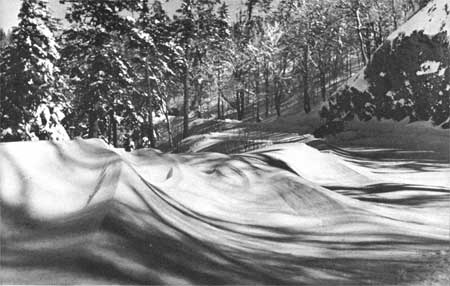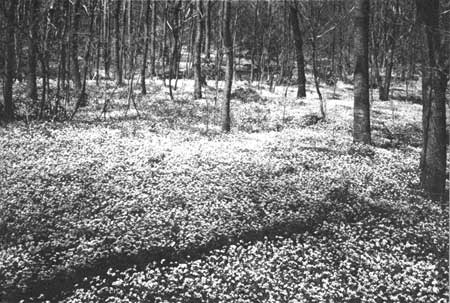|
GREAT SMOKY MOUNTAINS National Park |
 |
The Climate
What will the weather be like in June? In October? What kind of winters can you expect? Does it rain very often? When is the atmosphere clearest? In a park like the Great Smokies, where you must get out on the trails in order to have some of the most rewarding experiences, climatic conditions are important. Answers to questions of this kind are not as difficult to come by as they used to be, for each passing month and year adds its quota to the statistics. Nevertheless, in our temperate climate the months and the seasons vary considerably from year to year in the amounts of precipitation, in the extent and intensity of heat and cold, and in the number of clear and cloudy days.
Of the four seasons, winter is ordinarily the most unpredictable. Precipitation, usually in the form of rain in the lower altitudes and snow in the uplands, is quite variable. Generally, snowfall is light along the margins of the park and progressively greater as one gains altitude. Snow may accumulate to a depth of 3 feet in the spruce-fir zone, but such amounts are very infrequent. During the milder winters, snowfall may be very light throughout the park. Freezing rains may cause hazardous driving conditions along the transmountain road during this season, but workcrews are called out at all hours and sanding or snow-plowing operations may continue long into the night in order to keep the road clear. Ordinarily the motorist is not likely to be inconvenienced by snow and ice.
 The high Smokies receive more snow, more rain, and more fog than the surrounding areas of lower altitudes. The higher we go, the colder the temperatures and the shorter the growing season. Courtesy, Tennessee Conservation Department. |
Temperatures, in contrast to precipitation, decrease as you gain altitude. According to studies made by Dr. Royal E. Shanks, of the University of Tennessee, the average rate of temperature decrease is 2.23° F. per 1,000 feet. His research led him to the conclusion that in terms of both climate and vegetation the nearest low-altitude equivalent of the Great Smokies' spruce-fir forest region is located about 1,000 miles to the northeast—in northeastern Maine or adjacent New Brunswick.
Below-freezing temperatures are to be expected during much of the winter at the higher altitudes. Even in Gatlinburg, Tenn., at an elevation of 1,300 feet above sea level, the mean daily minimum temperature for the three winter months beginning with December is approximately 3° below the freezing point. The mean daily maximum, on the other hand, is 20° above the freezing point.
While spring may be knocking at the door of Great Smokies as early as January in some years, this welcome season may, on occasion, experience so many delays that its arrival may not materialize until late March or early April. A spring visit to the Great Smokies is particularly rewarding for those who are interested in wildflowers and in birds. Unlike the three winter months (December, January, and February) whose average temperatures show but little change, the months of spring (March, April, and May) show a rapid and steady rise both in the daily maximum and in the daily minimum readings. The reverse condition prevails in autumn. In the spring, precipitation will average about the same as in winter, both as to amount as well as to number of days with some precipitation. Hikers and campers should come prepared for a variety of weather conditions; those who hike the Appalachian Trail or other high-altitude trails will require warm clothing, especially in early or middle spring. At the lower levels, and in many of the towns and cities near the park, practically summerlike conditions prevail by middle May.
 Countless numbers of the fringed phacelia form white carpets in second-growth forests in late April. More than 200 species of plants are in flower at that time of year. Courtesy, Thompsons Photography, Inc. |
It is during the summer (June, July, and August) that park visitation is heaviest. This is also the hottest and wettest season of the year; brief afternoon or evening thundershowers are fairly frequent. For the most part the nights are cool enough for comfortable sleeping, but the days in the low-altitude communities usually range from warm to hot. However, you may obtain relief from high temperatures by driving to the higher Smokies, where cool weather is the rule. Blankets or sleeping bags and a raincoat are recommended for the high-altitude hiker or camper. Biting gnats occur in some localities at this season, especially near streams and damp places and where air drainage is inadequate. An insect repellent, therefore, should be included in your knapsack.
Colorful trees and the fine weather for outdoor activities make autumn the favorite Great Smokies' season for many visitors. These months (September, October, and November) are the driest of the year, and they are the months of the clearest atmosphere. Days of early autumn may be quite warm, while those late in the season may be wintry.

|

|
|
|
|
Last Modified: Sat, Nov 4 2006 10:00:00 pm PST |


